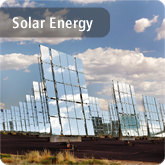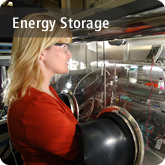A solar furnace uses a heliostat that tracks the sun to direct sunlight onto a mirrored parabolic dish. Because the focal point of the dish does not move, it is simple to install experiments. The power level of the furnace is adjusted using an attenuator that works like a venetian blind located between the heliostat and the dish.
The Test Facility has a small solar furnace with
- High-temperature solar thermochemical water-spitting experiments
- A heliostat that is 95 m²
- A dish that is 6.7056 meters in diameter
This furnace provides
- 16 kW total thermal power
- Peak flux up to 500 W/cm²
The furnace has a power control to simulate nuclear and other thermal transients

Applications include
- Investigating the thermophysical properties of materials in concentrated sunlight, including thermal expansion, thermal conductivity and diffusivity, specific heat, mechanical properties, and spectral emissivity and absorptivity
- Simulation of thermal effects of nuclear explosions on materials and components
- Determining the performance and failure thresholds of high-temperature ceramic and refractory materials
 ECIS Highlights
ECIS Highlights













 RSS
RSS Google+
Google+ Twitter
Twitter Facebook
Facebook LinkedIn
LinkedIn YouTube
YouTube Flickr
Flickr